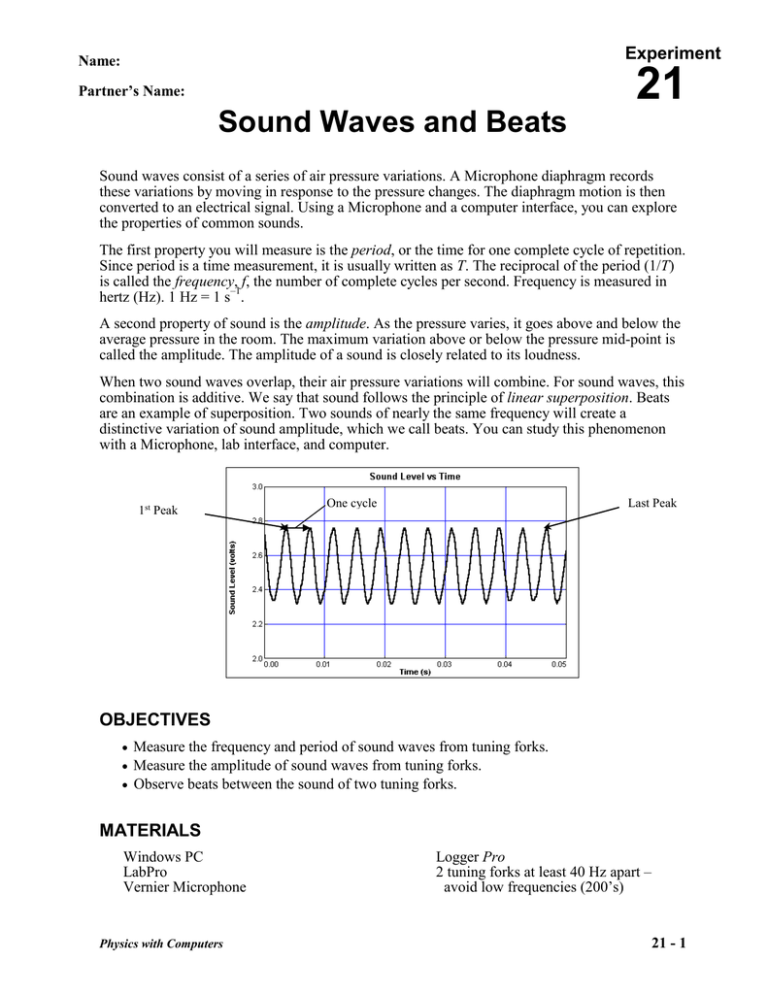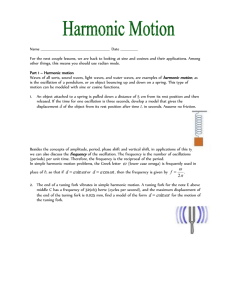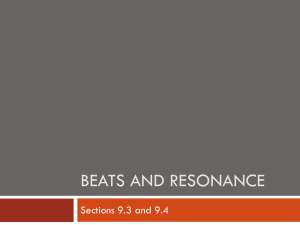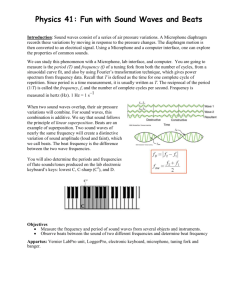21 Sound Waves and Beats Experiment
advertisement

Experiment Name: 21 Partner’s Name: Sound Waves and Beats Sound waves consist of a series of air pressure variations. A Microphone diaphragm records these variations by moving in response to the pressure changes. The diaphragm motion is then converted to an electrical signal. Using a Microphone and a computer interface, you can explore the properties of common sounds. The first property you will measure is the period, or the time for one complete cycle of repetition. Since period is a time measurement, it is usually written as T. The reciprocal of the period (1/T) is called the frequency, f, the number of complete cycles per second. Frequency is measured in hertz (Hz). 1 Hz = 1 s–1. A second property of sound is the amplitude. As the pressure varies, it goes above and below the average pressure in the room. The maximum variation above or below the pressure mid-point is called the amplitude. The amplitude of a sound is closely related to its loudness. When two sound waves overlap, their air pressure variations will combine. For sound waves, this combination is additive. We say that sound follows the principle of linear superposition. Beats are an example of superposition. Two sounds of nearly the same frequency will create a distinctive variation of sound amplitude, which we call beats. You can study this phenomenon with a Microphone, lab interface, and computer. 1st Peak One cycle Last Peak OBJECTIVES Measure the frequency and period of sound waves from tuning forks. Measure the amplitude of sound waves from tuning forks. Observe beats between the sound of two tuning forks. MATERIALS Windows PC LabPro Vernier Microphone Physics with Computers Logger Pro 2 tuning forks at least 40 Hz apart – avoid low frequencies (200’s) 21 - 1 Experiment 21 PRELIMINARY QUESTIONS 1. Why are instruments tuned before being played as a group? In which ways do musicians tune their instruments? 2. Given that sound waves consist of series of air pressure increases and decreases, what would happen if an air pressure increase from one sound wave was located at the same place and time as a pressure decrease from another of the same amplitude? PROCEDURE 1. Connect the Vernier Microphone to Channel 1 of the LabPro. 2. Open the file in the Experiment 21 folder of Physics with Computers. The computer will take data for just 0.05 s to display the rapid pressure variations of sound waves. The vertical axis corresponds to the variation in air pressure and the units are arbitrary. Part I Simple Waveforms 3. Produce a sound with a tuning fork by striking it on a rubber mat, hold it close to the Microphone and click . The data should be sinusoidal in form, similar to the sample on the front page of this lab. Striking the tuning fork against a hard object can damage it. If you strike the fork too hard or too softly, the waveform may be too rough; try again. 4. Note the appearance of the graph. Count and record the number of complete cycles shown after the first peak in your data. (See diagram on front of lab for clarification.) 5. Click the Examine button, . Drag the mouse across the graph and record the times for the first and last peaks of the waveform. Divide the difference, t, by the number of cycles to determine the period (T) of the tuning fork. (See diagram on front of lab for clarification.) 6. Calculate the frequency (f) of the tuning fork in Hz and record it in your data table. (Formula is on front of lab.) 7. Drag the mouse across the graph and record the maximum and minimum y values for an adjacent peak and trough. 8. Calculate the amplitude (A) of the wave by taking half of the difference between the maximum and minimum y values. Record the values in your data table. A = 1/2 (max. – min.) 10. Strike the tuning fork harder than before to produce a louder sound, hold it close to the microphone and click collect. Repeat steps 7 and 8. 11. Repeat Steps 3 – 9 for the second frequency. 21 - 2 Physics with Computers Sound Waves and Beats Part II Beats 12. Two pure tones with different frequencies sounded at once will create the phenomenon known as beats. Sometimes the waves will reinforce one another and other times they will combine to a reduced intensity. This happens on a regular basis because of the fixed frequency of each tone. To observe beats, strike your tuning forks at the same time (simultaneously). If the beats are slow enough, you should be able to hear a variation in intensity. If the beats are rapid a single rough-sounding tone is heard. 13. Strike the two tuning forks equally hard on the rubber mat and hold them the same distance from the Microphone. Collect data while the two tones are sounding. You should see a time variation of the sound amplitude. (See figure 1) Print this graph. 14. The pattern will be complex, with a slower variation of amplitude on top of a more rapid variation. Ignoring the more rapid variation and concentrating in the overall pattern, count the number of amplitude maxima after the first maximum and record it in the data table. (See figure 1 for clarification.) 15. Click the Examine button, . Drag the mouse across the graph and record the times for the first and last amplitude maxima. Divide the difference, t, by the number of cycles to determine the period of beats (in s). Calculate the beat frequency in Hz from the beat period. Record these values in your data table. Beat frequency = 1 / beat period DATA TABLE Part I Simple Waveforms Tuning fork frequency Number of cycles First maximum (s) Last maximum (s) t (s) Period (T) (s) Calculated frequency(f) (Hz) Tuning fork frequency Peak Trough Amplitude (V) (V) (V) Louder Peak Louder Trough Louder Amplitude (V) (V) (V) Part II Beats Number of cycles Physics with Computers First maximum (s) Last maximum (s) t (s) Beat (s) Calculated beat frequency (Hz) 21 - 3 Experiment 21 ANALYSIS Part I Simple Waveforms 1. On graph A, draw a wave of the same frequency that is louder than the original wave. 2. On graph B, draw a wave of the same loudness that has a higher frequency than the original wave. Graph A Graph B Part II Beats 3. Using the frequencies that are stamped on your two tuning forks, calculate the beat frequency. Show all work. Compare your answer with the calculated beat frequency in the data table. Figure 1 21 - 4 Physics with Computers





